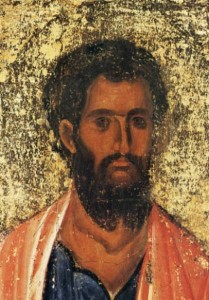 This semester I am taking a class on Christianity in the second century, where we are reading through Christian primary literature. For this class I have decided to catalog the different ways in which the apostles are used to promote a certain way of Christianity. For example, I want to see how Peter is used by the various second century writers to promote their own Christian self-identification and how this same figure is used to polemicize against other Christian groups. I am examining these texts from a historical point of view, rather than a theological perspective. In other words, I am not attempting to argue that one text is superior to another because one might hold to a more “orthodox” or “heretical” view than another. Rather, I am seeking to find the different ways in which Christianity expressed itself in the second century and, more specially, how they used apostolic figures to express these sometimes competing views. Because of this, I will speak of all these groups as Christian, and will do my best to avoid terms like “gnostic,” “heretical” and “orthodox.”
This semester I am taking a class on Christianity in the second century, where we are reading through Christian primary literature. For this class I have decided to catalog the different ways in which the apostles are used to promote a certain way of Christianity. For example, I want to see how Peter is used by the various second century writers to promote their own Christian self-identification and how this same figure is used to polemicize against other Christian groups. I am examining these texts from a historical point of view, rather than a theological perspective. In other words, I am not attempting to argue that one text is superior to another because one might hold to a more “orthodox” or “heretical” view than another. Rather, I am seeking to find the different ways in which Christianity expressed itself in the second century and, more specially, how they used apostolic figures to express these sometimes competing views. Because of this, I will speak of all these groups as Christian, and will do my best to avoid terms like “gnostic,” “heretical” and “orthodox.”
Let’s begin with James. In our earliest record of James, he is presented as one of the pillars of the Christian movement (Gal 2.9). This tradition of James as an authority is indicated again in Acts 15 and 21 and is supposed by second century writers based on the fact that they used his name to authorize their writings (see also the Epistle of Jude, where the author validates the letter by establishing a familial relationship with James [1.1]). In the NT, James is––for the most part––a consistent figure; namely Jewish. In the epistle bearing his name, James is adamant about keeping the Torah, and speaks about the Torah in terms of grandeur (“law of liberty,” 1.25; “royal law,” 2.8). The law also retains its function in the Jesus movement as a form of conviction (against favoritism, 2.9), and it does not appear that James is willing to be selective as to which portions of the law Christians must follow; rather the unity of the law is upheld in that if someone breaks one part of the law, he or she has violated the entire law. It should also be noted that James’ community gathers in a synagogue (2.2).
I am not convinced that Acts 15 speaks against the Jewishness of James or James’ Jewish vision for the church. The role of Gentiles in a Jewish community was a debated issue within the spectrum of Judaism. So it does not follow in my mind that the James of Acts is necessarily promoting a dichotomy between Christianity and Judaism. What is more important to notice about James at this point is that there is no indication that James despises the god of the Hebrew Scriptures or the Scriptures themselves.
Thus, in the NT, I believe the Jewishness of James is upheld or at least nothing definitively reveals James to be other than a promoter of some spectrum of Jewish Christianity.
In the middle of the second century, we find two apocalypses attributed to James. The First Apocalypse of James reveals a conversation between Jesus and James prior to Jesus crucifixion and another conversation between the risen Jesus and James prior to James’ martyrdom. In the Second Apocalypse of James, we find James on trial, reporting to his accusers about conversations he and Jesus had in the past, after which he is stoned.
There is a significant difference between the James of the First Apocalypse and that of the second. The former has a positive view of the god of the Hebrew Bible (HB). This god is the one who is unnamable and ineffable (1 Apoc. Jas. 24). Jesus comes from him and is his image (1 Apoc. Jas. 24, 25). In the Second Apocalypse, however, the god of the HB is viewed in a much more negative light:
“Your father [god of the HB], whom you consider rich, will grant that you inherit all that you see.…His inheritance, which he boasted about, claiming it was great, will prove to be insignificant. His gifts are not blessings and his promises are evil intrigues. You are not of <the children> of his compassion, but he does violence against you. He wants to do injustice against us. And he will have dominion for a period of time appointed for him” (2 Apoc. Jas. 52, 53).
In similar sentiment, we read:
The creator god [of the HB] cannot perceive the light of the supreme Father and he merely uses the light. “Because of this he [utters curses], and because of this he boasts, that he may not be rebuked. For this reason he is superior to those who are below, who were looked down upon, in order to be perfected in them. After he captured those who are from the Father, he seized them and shaped them to resemble himself and so they are with him” (2 Apoc. Jas. 54).
By contrast, the author of the Second Apocalypse views the supernal Father as the superior deity:
“But understand and know the Father who has compassion, who was not given an inheritance, whose inheritance is unlimited, with an unlimited number of days.” Rather, it is an eternal [day], and it is [light]” (2 Apoc. Jas. 52–53).
That the author of Second Apocalypse is polemicizing against the god of the Jews is clear. It would follow then that this author has appropriated the representative leader of the church for a more non-Jewish purpose; namely, the rejection of the Jewish god and, thus, all things promised by the this god (e.g., land, long earthly life). This is diametrically opposed to the James we find in the Epistle (who reveals no animosity against the god of the HB, seemingly view the Torah in high regard [1.25; 2.8–12], and still envisions the community meeting in a synagogue [Jas 2.2]) and is more extreme than the James we find in Acts (wherever one might place the James in Acts on the Jewish/Christian spectrum, he never rejects the god of the HB).
Aside from their disparate views on which god constitutes the true and supreme deity, these two works are homogenous on some fairly substantial points. Both works decry the flesh and look toward a time when their terrestrial bodies can be defenestrated (1 Apoc. Jas. 27; 32; 2 Apoc. Jas. 57; 63). In spite of the author of the First Apocalypse affirming and praising the Jewish god, he nevertheless joins the author of Second Apocalypse in condemning the terrestrial as perishable, impure, and ignorant and anticipating the imperishable supernal life (1 Apoc. Jas. 28; 2 Apoc. Jas. 46; 60).
Thus, in the two apocalypses of James we find both continuity and discontinuity. The two James’ agree that the flesh is to be dispensed and they both condemn the terrestrial realm because of its inherent failures and both look forward to an eternal life of supernal bliss. However, James becomes schizophrenic when we look at his view of the Jewish god; the author of the First Apocalypse favors the Jewish god and never mentions the possible existence of another greater deity, while the author of the Second Apocalypse rescinds the authority of the Jewish god––claiming he only promised things that were perishable––and exalts the supernal god––who promises immortality. In other words, in the 1 Apocalypse of James we find a Jewish James, while in the 2 Apocalypse of James we find a non-Jewish James, who actually rejects the Jewish god. They perceive of their future in similar terms but perceive of their pasts in very oppositional ways.



Though God was himself perfect, the knowledge of him was being perfected in man as mankind advanced towards the future. The Jewish James was about the first phase of the revelation of the nature of God; the none Jewish James was about the second phase of the revelation of God. The first phase (or the first lesson) about God was about God the Father; while the second phase (or the second lesson) about God was about God the Son. There was also a third and final phase dedicated to God the Holy Spirit. The three phases are united into what is called the Blessed Trinity.
The Jewish James was about God the Father, the None Jewish James was about God the Son, and there is the invisible God the Holy Spirit.
Anyone curious about God must seek to understand the scientific meaning of the Blessed Trinity. Scientific methods were put in place to explain the Blessed Trinity; and only a few had the privilege.
Did you just link science with the trinity? Like, 21st century science? Really?
At the end: “and only a few had the privilege.” Privilege for what?
Doesn’t the idea of the trinity demand a harmonious unity. That is, if a source is going to emphasize the son, it does so but not at the expense of the father. If you agree with this then you argument can’t stand because the 2 Apoc of James highlights something other than the father at the expense of the father––it completely dismisses any positive notion of the father. There can be no notion of a harmonious trinity in 2 Apoc of James because it rejects one of the members.
Also, (and it’s been long while since I’ve read these docs) I would imagine that the 2 Apoc of James condemns anything material. This is why it condemns anything made by the father of the HB. If it is condemning material things then it would also condemn a physical body of the son. Does that coincide with your view of the trinity? I would imagine not.